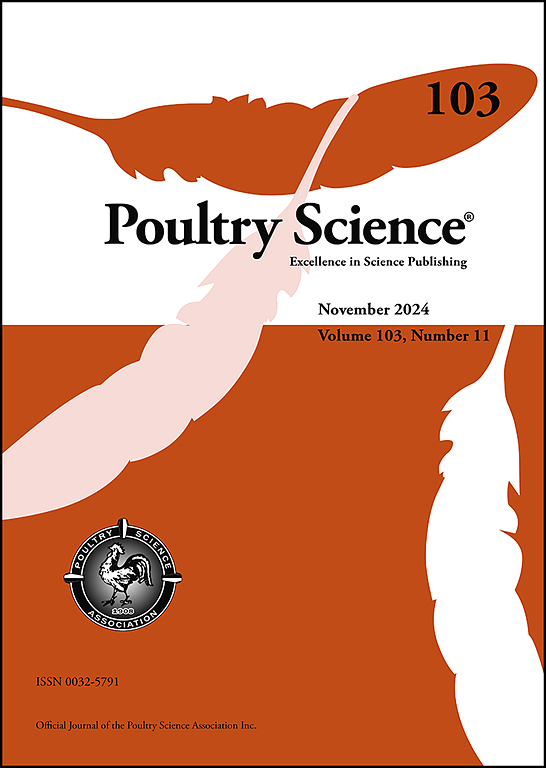Effects of inclusion of black soldier fly larvae on growth performance, relative organ weight, and meat quality of broiler chickens
IF 3.8
1区 农林科学
Q1 AGRICULTURE, DAIRY & ANIMAL SCIENCE
引用次数: 0
Abstract
The objective of this experiment was to investigates effects of inclusion of black soldier fly larvae (BSFL) on growth performance, relative organ weight, and meat quality of broiler chickens. A total of 180 1-d-old broiler chickens were randomly allotted to 1 of 3 dietary treatments with 5 replicates. Each replicate consisted of 12 birds. Experimental diets were formulated to contain full-fat BSFL at inclusion levels of 0 %, 1 %, and 2 %. These diets were provided on an ad libitum basis for 5 wk. Results indicated that birds fed diet containing 1 % BSFL had greater (P < 0.05) feed efficiency than those fed diets containing 2 % BSFL. However, BW gain and feed intake of broiler chickens were not affected by increasing inclusion levels of BSFL in diets. Increasing inclusion levels of BSFL in diets showed a quadratic relationship (P < 0.05) with relative thymus weight. For meat color, values for redness (a*) and yellowness (b*) were decreased (linear, P < 0.05) as BSFL inclusion level of diets increased. Thiobarbituric acid reactive substance decreased (quadratic, P < 0.05) with increasing inclusion levels of BSFL in diets. Melanin concentrations in breast meat and liver characteristics were not affected by increasing inclusion levels of BSFL in diets. Increasing concentrations of BSFL in diets increased myristic acid concentrations (linear, P < 0.01) and eicosapentaenoic acid concentrations (linear, P < 0.05) in breast meat. These results suggest that dietary supplementation of BSFL has positive effects on immune organ weight, breast meat quality, and fatty acid compositions in breast meat. Therefore, BSFL can be used as a feed ingredient for broiler chickens. Also, we suggest that dietary supplementation of 1 % BSFL improves the performance and health of broiler chickens.
包埋黑虻幼虫对肉鸡生长性能、相对脏器重和肉品质的影响
本试验旨在探讨黑兵蝇幼虫(BSFL)对肉鸡生长性能、相对脏器重和肉品质的影响。试验选用180只1日龄肉鸡,随机分为3个饲粮处理,每组5个重复。每个重复由12只鸟组成。试验饲粮中分别添加0%、1%和2%的全脂BSFL。试验期为5周。结果表明,饲粮中添加1% BSFL的雏鸟(P <;0.05)饲料效率高于添加2% BSFL的饲料。然而,肉鸡的体重增重和采食量不受饲粮中添加BSFL水平的影响。饲粮中BSFL添加水平的增加呈二次曲线关系(P <;0.05),胸腺相对重量。对于肉色,红度(a*)和黄度(b*)的值降低(线性,P <;0.05),随着饲粮BSFL添加水平的升高。硫代巴比妥酸活性物质减少(二次,P <;0.05),随着饲粮中BSFL添加水平的增加。胸肉中的黑色素浓度和肝脏特征不受饲料中添加BSFL水平增加的影响。饲粮中BSFL浓度的增加增加了肉豆蔻酸浓度(线性,P <;0.01)和二十碳五烯酸浓度(线性,P <;0.05)。由此可见,饲粮中添加BSFL对肉鸡免疫器官重量、胸肉品质和胸肉脂肪酸组成有积极影响。因此,BSFL可作为肉仔鸡的饲料原料。由此可见,饲粮中添加1% BSFL可改善肉鸡的生产性能和健康状况。
本文章由计算机程序翻译,如有差异,请以英文原文为准。
求助全文
约1分钟内获得全文
求助全文
来源期刊

Poultry Science
农林科学-奶制品与动物科学
CiteScore
7.60
自引率
15.90%
发文量
0
审稿时长
94 days
期刊介绍:
First self-published in 1921, Poultry Science is an internationally renowned monthly journal, known as the authoritative source for a broad range of poultry information and high-caliber research. The journal plays a pivotal role in the dissemination of preeminent poultry-related knowledge across all disciplines. As of January 2020, Poultry Science will become an Open Access journal with no subscription charges, meaning authors who publish here can make their research immediately, permanently, and freely accessible worldwide while retaining copyright to their work. Papers submitted for publication after October 1, 2019 will be published as Open Access papers.
An international journal, Poultry Science publishes original papers, research notes, symposium papers, and reviews of basic science as applied to poultry. This authoritative source of poultry information is consistently ranked by ISI Impact Factor as one of the top 10 agriculture, dairy and animal science journals to deliver high-caliber research. Currently it is the highest-ranked (by Impact Factor and Eigenfactor) journal dedicated to publishing poultry research. Subject areas include breeding, genetics, education, production, management, environment, health, behavior, welfare, immunology, molecular biology, metabolism, nutrition, physiology, reproduction, processing, and products.
 求助内容:
求助内容: 应助结果提醒方式:
应助结果提醒方式:


